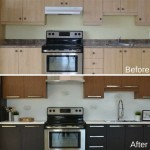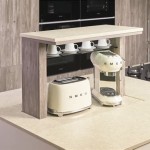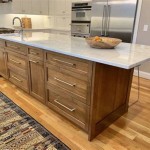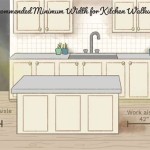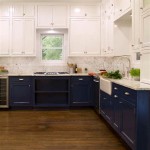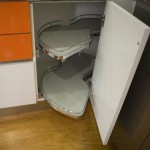Built-In Kitchen Buffet Cabinet Ideas: Enhancing Functionality and Style
Built-in kitchen buffet cabinets provide an elegant and practical solution for optimizing storage and enhancing the aesthetic appeal of the kitchen and dining areas. Unlike freestanding furniture, built-in units are seamlessly integrated into the architecture of the space, creating a custom look and maximizing usable area. The following article explores various built-in kitchen buffet cabinet ideas, focusing on aspects such as design considerations, material choices, stylistic integration, and functional features that contribute to an effective and visually pleasing space.
Planning and Design Considerations
The initial phase of implementing a built-in kitchen buffet cabinet involves careful planning and design. A thorough assessment of the available space is paramount, considering factors such as wall dimensions, existing architectural features, and the overall layout of the kitchen or dining area. Accurate measurements are crucial to ensure a precise fit and a visually balanced design.
Functionality is a key determinant in the design process. The intended use of the buffet cabinet must be clearly defined. Will it primarily serve as storage for dinnerware, glassware, linens, or perhaps a combination of items? The specific storage needs will dictate the internal configuration of the cabinet, including the number and type of shelves, drawers, and specialized compartments.
Ergonomics plays a significant role in enhancing usability. The placement of frequently used items should be easily accessible, minimizing the need for bending or reaching. Countertop height should be appropriate for food preparation or serving, typically aligning with standard kitchen counter heights. The depth of the cabinet should also be considered, ensuring sufficient space for storage without obstructing traffic flow within the room.
Aesthetically, the design should complement the existing style of the kitchen or dining area. The architectural style of the home, the color palette, and the hardware finishes should all be taken into account to create a cohesive and harmonious look. A well-integrated design will appear as a natural extension of the room, rather than an afterthought.
Consideration must also be given to lighting. Interior cabinet lighting can enhance visibility and showcase stored items, while strategically placed external lighting can highlight the buffet cabinet as a focal point within the room. LED strip lighting is a popular choice due to its energy efficiency and versatile application.
Material Selection and Construction
The selection of materials is critical for both the durability and aesthetic appeal of the built-in kitchen buffet cabinet. The choice of materials should be based on factors such as budget, desired aesthetic, and the level of maintenance required.
Wood is a classic choice for cabinet construction, offering a range of options in terms of species, grain patterns, and finishes. Hardwoods such as maple, oak, and cherry are known for their durability and resistance to wear, making them suitable for high-use areas. Softwoods such as pine and cedar are more affordable but may require more care to prevent dents and scratches. The choice of wood should be consistent with the overall style of the kitchen. For example, a modern kitchen might benefit from the clean lines of maple, while a traditional kitchen could be enhanced by the warmth of cherry.
Plywood and MDF (Medium Density Fiberboard) are commonly used for cabinet boxes due to their stability and affordability. High-quality plywood is preferred for its resistance to moisture and warping, while MDF provides a smooth surface for painting or laminating. The core material is typically concealed by the cabinet doors and face frames.
Countertop materials play a significant role in the overall aesthetic and functionality of the buffet cabinet. Granite, quartz, and marble are popular choices for their durability, heat resistance, and elegant appearance. Solid surface materials such as Corian offer a seamless and non-porous surface, making them easy to clean and maintain. Laminate countertops are a more affordable option, providing a wide range of colors and patterns.
Hardware finishes should complement the overall design of the cabinet and the existing hardware in the kitchen. Options include brushed nickel, polished chrome, oil-rubbed bronze, and matte black. The style of the hardware should be consistent with the overall aesthetic, whether it is traditional, modern, or transitional.
The construction method also influences the durability and longevity of the cabinet. Dovetail joinery is a traditional method known for its strength and aesthetic appeal. Dado joints and pocket screw construction are more modern methods that provide a secure and efficient way to assemble cabinet components. The choice of construction method should be based on the desired level of quality and the budget.
Stylistic Integration and Functional Features
The success of a built-in kitchen buffet cabinet lies in its ability to seamlessly integrate with the existing style of the room while providing practical storage and functionality. A variety of stylistic approaches can be employed to achieve this balance.
Traditional buffet cabinets often feature ornate detailing, raised panel doors, and decorative moldings. Elements such as fluted pilasters, corbels, and crown molding can add a touch of elegance and sophistication. Traditional styles often incorporate darker wood finishes such as cherry or mahogany, complemented by brass or antique bronze hardware.
Modern buffet cabinets typically feature clean lines, minimalist designs, and a focus on functionality. Flat panel doors, frameless construction, and concealed hardware are common characteristics of modern styles. Materials such as stainless steel, glass, and acrylic are often incorporated to create a sleek and contemporary look. Lighter wood finishes such as maple or birch are often used in modern designs, along with neutral color palettes.
Transitional buffet cabinets strike a balance between traditional and modern elements. They often feature simple shaker-style doors, clean lines, and a mix of natural and synthetic materials. Transitional styles allow for a wide range of color palettes and hardware finishes, providing flexibility in matching the existing décor.
Functional features can significantly enhance the usability of the buffet cabinet. Adjustable shelves allow for flexible storage of items of varying sizes. Pull-out drawers provide easy access to stored items and can be equipped with dividers to keep items organized. Wine racks, glass holders, and silverware inserts can be incorporated to create specialized storage solutions. Soft-close hinges and drawer slides provide a smooth and quiet operation, while also preventing slamming and damage.
Electrical outlets can be integrated into the buffet cabinet to provide power for small appliances such as coffee makers, blenders, or warming trays. This is particularly useful if the buffet cabinet is intended to be used as a serving area. Under-cabinet lighting can provide task lighting for food preparation or serving, while also enhancing the aesthetic appeal of the cabinet.
Decorative elements such as glass doors, open shelving, and display niches can be incorporated to showcase treasured items or collections. These elements can add visual interest and personalize the buffet cabinet to reflect the homeowner's style. The choice of decorative elements should be consistent with the overall style of the room.
Finally, the placement of the built-in buffet cabinet should be carefully considered to optimize functionality and traffic flow. It should be located in an area that is easily accessible from both the kitchen and the dining area, allowing for convenient serving and storage. The size and scale of the cabinet should be proportional to the size of the room, ensuring that it does not overwhelm the space. A well-planned and thoughtfully designed built-in kitchen buffet cabinet can significantly enhance the functionality and aesthetic appeal of any kitchen or dining area.

Built In Buffet Kitchen Design Ideas Pictures Remodel And Decor Dining Room Storage

52 Built In Buffet Sideboard Ideas Dining Room Ins

Built In Sideboard Design Ideas

Built In Kitchen Cabinet Makeover

Galley Kitchen With Built In Buffet Crystal Cabinets

39 Best Built In Buffet Ideas Dining Room Ins

Avoid This Common Kitchen Design Mistake For A Stunning Space

Built In Sideboard Cabinet Design Ideas

Built In Buffet Design Ideas

Galley Kitchen With Built In Buffet Crystal Cabinets
Related Posts

